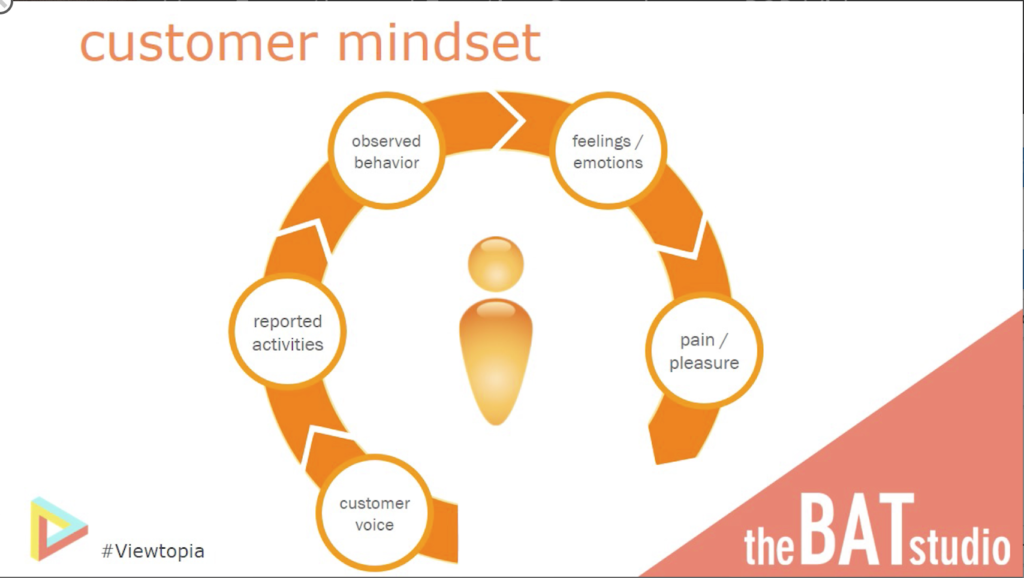If you’re a marketer who’s done any dabbling in video, you likely already know all about how important emotion is in your video marketing. Throw in some awww-worthy puppies or use some slapstick Three Stooges humor and you’ve got it made. If you can get your viewers laughing or crying, you’ve probably hit the jackpot, right?
Turns out, emotional marketing is a little more complicated. But don’t sweat – at Viewtopia, the world’s best video marketing summit, Chris Harmon of boutique consultancy firm theBATstudio gave a great talk on what’s really involved in emotional marketing, and how to take it to the next level to develop a real and lasting connection with your audience.
So what’s really involved? Even if you couldn’t be at Viewtopia in person, we’ve got you covered with exactly what you need to know! Here are 6 key points from Chris’s talk:
1. Empathy can have a significant impact on the success of video marketing
Marketers know that emotion in marketing is key. But it goes deeper than that; you don’t just want to settle for any old emotion. You need to create empathy! Empathy, as Chris puts it, lets your audience know that you understand who they are, and you feel their emotions and connect with them. Essentially, you understand and share your potential customers’ feelings.
Video is the perfect medium to express empathy – you can display emotion so much easier than in other formats, and elicit it in your audience. When they see what you’re feeling, they’re likely to feel the same. It’s science.
If you can go beyond just trying to make someone laugh to discovering their emotions, and then empathizing with them through your video, you’re more likely to hold your audience’s attention, speak to their needs and desires, and get better results. It’s a must that you get your company (and your execs) on board with moving beyond talking about “speeds and feeds”, as Chris says, and stop jabbering about your product to instead focus on how you will solve your audience’s problem. You need to show them that you can either alleviate their pain, or increase their sex appeal (a.k.a. give them something they really want). If you want to learn more about the secrets to emotional marketing videos, check out this post!
2. Learn to understand and empathize with your customer through their mindset
To create empathy in our videos, first we have to understand how our employees are feeling. Chris talks about the five steps that help you get to the bottom of it all:

- Customer voice – The customer voice is what a business “thinks” its customers believe. Many companies start – and stop – here when trying to understand and relate to their customers. It’s not fully effective because perception does not always equal reality.
- Reported activities – Through interactions with you, (also considered reported activities), your customers are telling you to some degree what they feel about you. (e.g. If they visit your website and bounce quickly, they’re telling you about their lack of interest and engagement with you.)
- Observed behavior – You can get a better, more honest impression of what your customers truly feel if you go where your customers are and watch them.
- Feelings and emotions – What are the emotions people are going through as they engage in behaviors with you? (e.g. looking at your website). Try to engage with them based on what they would be feeling during different actions.
- Pain/Pleasure – Remember that people think in terms of how they can avoid pain, and how they can gain pleasure. If you can tune your message so it answers those questions and provides the feelings your customers are looking for, they’ll have a stronger connection with you.
3. Demonstrate empathy through your content
When you know what your potential customers are feeling (and what they want to feel), you don’t need to force product-heavy messages onto your audience. When theBATstudio worked to create videos for Oracle Eloqua, they didn’t just create a bunch of product videos from their point of view.
Instead, they had Eloqua customers do the talking. Why? Because they felt the same things, went through the same struggles, and wanted to feel the same emotions and achieve similar things that potential customers do. That meant that potential customers could empathize with the customers and the customer-centric storytelling much better than they would relate to any brand-constructed message. These customer stories, which are still available on their website, achieve a great level of success because the key is to create a message that isn’t about you, but rather what you do for others.
4. Create an ongoing narrative
You can try to create a funny video over here for this campaign, and a tear-jerker over there for that landing page. But you know what’s a better idea? Creating an ongoing narrative that brings your viewers through a journey. This helps them connect deeper and deeper to your message (and you) as they are swept into your story. That’s what theBATstudio did with Lenovo when they created the “Users Happen” campaign. Watch the three videos in the campaign series to experience the continuous story for yourself:
Now, to create an ongoing narrative, you don’t need to have the same actors, set, or specific situation. In this case, Lenovo introduces a problem to relate to their IT audience, sets up a worse problem to create empathy and let IT people know that Lenovo really understands their ongoing pain, and in the final video, the IT workers are positioned as the heroes that solve problems and save the day. The narrative doesn’t focus on “speeds and feeds”, but rather on the hero’s journey, bringing the audience through a relatable and emotional narrative that ends with them as the star. The campaign, which helped potential users understand the ruggedness and reliability of Lenovo products, was a success: 85% of viewers watched the videos all the way through, and the campaign brought in 2,318 MQLs and $10 million in revenue!
5. Connect video engagement to business drivers
One of the key takeaways Chris emphasized in his talk? That you must connect the dots between your audience’s engagement with your videos, and your results. It’s not enough to create funny videos and have people watch them. As marketers know, just because someone watches a video doesn’t mean they’re willing or even interested in buying – they may just want to be entertained.
Look at your metrics to determine not just views, but how long people are watching, which videos they’re watching, what the click-through rates are, and more. While video is becoming more and more accessible to everyone, it’s still not as cheap to produce as a whitepaper or infographic. So if you can prove how your video marketing is impacting your business results, including MQLs and closed deals, then you’ll reach greater success.
6. Your video marketing can positively impact you – and your customers
One of the most interesting parts of Chris’s talk proved the full impact of video marketing. Working for the company that built the most powerful video marketing platform, I already knew how much it can do for businesses, and the impressive results companies can get when they use video. But when you create videos to educate your audiences and sell to customers, are you thinking about what those videos can do for your customers? I’m not talking about the direct impact of your video and your product on your customers’ business.
Chris shared an anecdote about how theBATstudio had worked with Oracle Eloqua on creating videos about how their customers are having great success with Eloqua. They were personal and created empathy because the viewers would relate to what the customers on camera were saying (see point 3). But the really interesting thing? Almost 80% of the customers who were in the videos went on to become VP or CMO of marketing in their company or at another company within a year! What does this suggest? Possibly that video marketing helps you establish so much empathy that, if you’re on camera and talking passionately about what you believe in, you can build trust and credibility in your professional role. Video marketing clearly has an amazing impact not only on your own business, but on your customers’ lives!
Interesting, huh? If you went to Viewtopia this year, what was the most interesting thing you learned? If you didn’t get to go, there’s always next year, and in the meantime, check back on the blog or the Viewtopia hub for more takeaways from the best video marketing summit!
The post Emotional Marketing: How to Supercharge Your Results appeared first on Vidyard.
source http://www.vidyard.com/blog/how-to-supercharge-your-results-with-emotional-marketing-and-video/


No comments:
Post a Comment